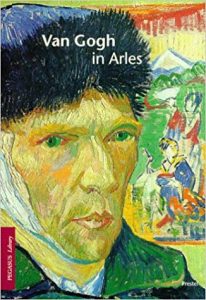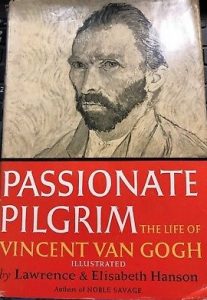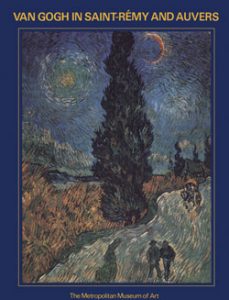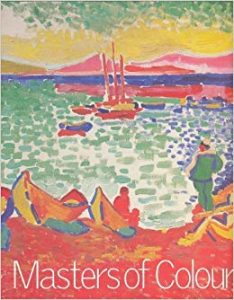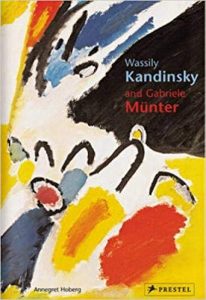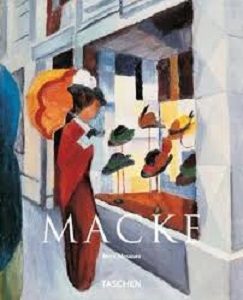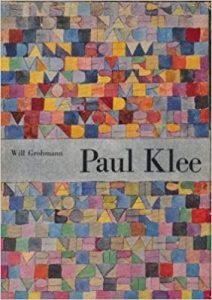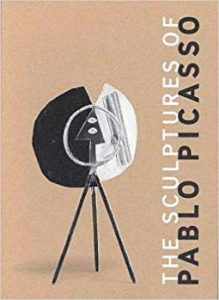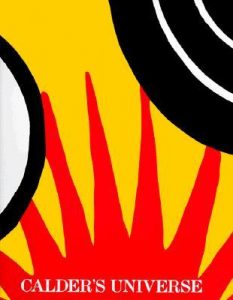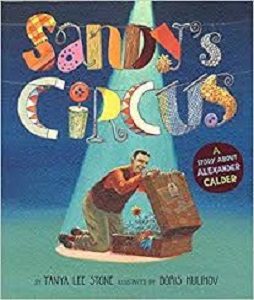
An interview with poet Eléna Rivera
13 May 2019
Modern manifestos on display
16 May 2019The Library is pleased to present the Culture Picks for the month of May, curated, researched and written by Library volunteer Mike Duffy.
May Culture Picks brings us three outstanding exhibitions of artists who decisively influenced the development of modern art across painting, sculpture, printing and drawing and changed the conception of art and of the artist. First, and the only one who did not work in the 20th Century is Vincent Van Gogh, whose revolutionary work is astonishingly transformed in a 21st-Century sound and light presentation Van Gogh, Starry Night at L’Atelier des Lumières. Next, Franz Marc / August Macke: The Adventure of the Blue Rider at L’Orangerie showcases a group of innovative experimenters with painting and prints, with representation versus abstraction, with theories of color who worked in Munich during the three years immediately before World War I. Lastly, two 20th-century giants appear at the Musée Picasso Paris—Calder and Picasso—who challenged and changed notions of what sculpture could be and had a lot of fun doing that.
As always, we’ve selected books from our collection to go with the cultural visits. These books are displayed in the Members’ Lounge and available to be checked out.
Guest blogger: Mike Duffy lives in Paris following his retirement from a career in university teaching and management. He spent his first 30 years in Pennsylvania (born in Pittsburgh, college and grad school in Philadelphia), then spent a bit more than that in California where he taught accounting and finance at the Universities of California (Berkeley), Southern California and San Francisco. He can now be found in art museums, historic sites, and concert halls throughout the city.
VAN GOGH, STARRY NIGHT
ATELIER DES LUMIERES
Through 31 December 2019
The dazzling brilliance of Vincent Van Gogh surrounds you in the truly 21st Century immersive experience of art, light, music and color Van Gogh, Starry Night at the Atelier des Lumières in the 11th arrondissement of Paris. This is a high definition, huge format experience of moving images—images which move around you and which move you. This stark former industrial building bursts and bristles in a thoroughly captivating, enjoyable and entirely novel presentation of the innovative work of a genius which can be enjoyed by people of all ages.
From the dark domestic interior of The Potato Eaters (1885) to the intense golden-yellows of wheat fields and sunflowers, more than 500 works by Van Gogh are magnified and pass over, under and around you. Entire paintings or just small details fill 30 foot high walls, float across hundreds of feet of wall space and carpet the floor under you. It is amazing that the scaling up of the artworks does not blur detail; in fact, you can see the length of brushstrokes, the thickness of the paint, even the ridges made by the paintbrushes. This is reproduction unlike any prior printed or projected format.
The well known intensity of the life and work of Van Gogh (1853-1890) comes through in portraits, interiors, outdoor scenes and self-portraits accompanied by an amazingly varied soundtrack: classical music along with jazz and pop from artists as different as Vivaldi and Miles Davis or Nina Simone and Brahms mixed by and including original works by composer Luca Longobardi. The range of sounds matches the images which span the Van Gogh’s career from the dreary Netherlands to sun-filled San-Rémy-de-Province and Arles, then finally to the Auvers-sur-Oise. Iris, sunflowers and cypress splash across the walls mixing with portraits of neighbors and, especially, self-portraits displaying the styles which developed over the brief, ten year career of the iconic troubled artistic soul.
In more than 35,000 square feet, 140 projectors and 50 speakers bring alive the creative genius of artistic director Gianfranco Iannuzzi, director Renato Gatto, and director and videographer Massimiliano Siccardi rendering the wondrous works of Van Gogh in monumental scale. Across time, changing technologies have provided different, enriching experiences of art to larger and more varied audiences and Van Gogh, Starry Night uses digital / electronic technologies to provide a new experience of art and music. Sound and light shows which flash spotlights on ruins in Mexico or Rome and wondrous contemporary digital displays such as that at the cathedral in Rouen are surpassed not just in scale but also in conception and execution at the Ateliers des Lumières.
Van Gogh, Starry Night offers an experience for art lovers, experience seekers, the curious and the digital generation who look, listen, walk around, sit on the floor or stairs. (Note: there are almost no seats.) People enter and leave at any point during the continuous show, which includes, additionally, Dreamed Japan by Studio Danny Rose, a short digital image experience of the floating world of Japanese prints, whose vibrant colors and dreamlike images influenced Van Gogh and his contemporaries. In a separate, smaller room there is also Verse by Thomas Vanz, a mystical, mysterious presentation of stars, the cosmos, astrophysics and music. Light, sound, color and music now fill this 180-year-old foundry with the pleasant, refreshing joy of sunlight and starry nights.
Recommended books from the Library collection:
FRANZ MARC / AUGUST MACKE: THE ADVENTURE OF THE BLUE RIDER
MUSEE DE L’ORANGERIE
Through 17 June 2019
The most notable characteristic of the artists of the short-lived Munich-based group known as The Blue Rider is their desire to be new, to be free of the strictures of the old regime in the arts and politics, and the works of Franz Marc, August Macke and others on display at L’Orangerie exemplify that spirit of adventure. Before the formation of The Blue Rider in 1911, both Marc and Macke were painting beautiful, “modern” works influenced by artists whose works they had encountered in Paris. Marc moved gradually to paint boldly colored, increasingly simplified animals and Macke absorbed the influences of art nouveau and Japanese design as they, along with those who would form The Blue Rider, strove to be daring, avant-garde, experimental artists looking to create the art of the future.
The work of Franz Marc (1880-1916) evolved from contemporary portraits and scenery to fabulous brightly colored horses and other animals in increasingly abstract settings. He is clearly part of the German Romantic tradition with its emphasis on nature and the outdoors and over time he aligned with the intellectual spiritualism and abstract tendencies of his friend Wassily Kandinsky, the leader of The Blue Rider, to create Expressionistic paintings which moved far beyond his earlier work. His Linge flottant dans le vent (Laundry floating in the wind, 1906) and Cavalier sur la plage (Rider on the beach, 1907), for example, show a keen appreciation for the strong, quick brushwork of late 19th Century Parisians to capture motion and a desire to depict ordinary life rather than the uplifting, moralistic scenes typical of the German Romantics. By 1909, Petite étude de pierres (Small study of rocks, 1909) reveals that he has seen and appreciated the angular work of Cézanne. In a color lithograph Chevaux dans le soleil (Horses in the sunlight, 1908-1909) Marc revels in the realistic shapes of muscular horses against a recognizable but almost abstract background of trees and by 1911 and 1912 he is painting blue and white horses as well as weasels playing under purple and reddish-orange trees against a ground of round-edged patches of yellow, green and purple. He developed a Pantheistic sense of “the organic rhythm of all things” and by 1913 in Écuries (Horse stalls) red and orange and yellow horses appear amidst an abstract geometry of strong blues, reds, greens which sometimes swirl and other times are at sharp angles. The growing disintegration of European peace in 1913 confronts the viewer as red, black and brown wolves menace their prey in Les Loups (The wolves), also titled Guerre des Balkans (Balkan war). The sharp, angular shapes of the animals along with the abstract background of disordered rectangles and spheres in muted shades of purple-pink, blue-green, yellow-orange slashed with black reflect the impending chaos.
August Macke’s paintings begin in a direct line from the painters he met on trips to Paris and evolve to simplified, mostly figurative works. The influence of Cézanne is apparent in an early still life and especially in a wonderful, warm portrait of his friend Franz Marc. In addition, Torrent de forêt (Forest Stream, 1910) shows the influence of Gauguin in its heavily outlined trees and quick strokes of green, red, yellow, orange and violet representing the forest foliage. At the same time, Macke (1887-1914) erases many features but retains a relative realism in Portrait de Mme Macke (Portrait of Madam Macke, 1911) and in charming pictures of his son’s toys and of geraniums on a railing. All three of these include large, flat planes of color rather than fine detail and, in the case of the latter two, a childlike joy. Macke continued painting people — walking in a forest or at a lakeside café — in a simplified manner while the settings became more abstract, a bit geometric, with trees in oranges and greens and blues and yellows. Finally, in 1913 Macke is painting formal, very geometric studies of the relationships of colors including a very precise Carreaux de couleur (Colorful diamonds) along with interesting, attractive rectilinear forms with blurred edges in Formes colorées (Colorful shapes). These are less dynamic than works of Franz Marc painted around the same time in which the color blocks jut along diagonals and they reveal the more formalistic, less spiritual side of Macke. His final watercolors from a 1914 trip to Africa show him incorporating flat patches of color, continuing his development as a 20th Century artist, absorbing influences and adapting technique to present recognizable figurative works.
The Blue Rider as a group, as organizers of exhibitions, as creators of a single issue of The Blue Rider Almanac were deliberately European. They wanted a future for art and for their lives which without imperial boundaries, national borders and ethnic divisions as did other thinkers and artists of the period such as the influential Zurich writer Stefan Zweig. In their membership, print publications and gallery exhibitions (as in this exhibition) they included Paul Klee (Swiss), Wassily Kandinsky (Russian), Robert Delaunay (French) Sonia Delaunay (Ukrainian to French), the Swiss-French poet Blaise Cendars, along with the Germans Marc, Macke and Gabriele Münter. The old German art establishment damned Marc and Macke as “too French” which is ironic as the art elite in France called the immigrants who similarly revolutionized art in that country as “The School of Paris”, refusing to call them French. Later, the National Socialists (Nazis) would classify much of the work of The Blue Rider artists as “degenerate”. And while they aimed to be European, these artists, especially, for example, Macke, incorporated Japanese and other non-western influences, and their Almanac included South Pacific, African, Egyptian and Russian pieces.
While the First World War sundered The Blue Rider, it was never a movement with a unified aesthetic. The Fauves and Cubists from France and elsewhere along with the Futurists from Italy were welcomed as they represented novel approaches to painting, sculpture, poetry and music and, in turn, were influenced by Marc and the others. There was tension between figurative painters and those who came to believe that abstraction alone was the appropriate means of expressing ones insights, thoughts or feelings. The swirling, colorful paintings of urban scenes by Robert Delaunay; the flat, color grids of Klee; the abstractions through which Kandinsky tried to capture the spiritual in art; the organic, brightly colored design of Sonia Delaunay accompanying a poem by Blaise Cendrars — all were included in the very short period 1911 to 1914 that is the life of The Blue Rider. The insistence on the spiritual role of the artist in particularly lyrical works by Kandinsky and Marc alienated the rational formalist Macke. What artistic tension did not drive apart, the First World War did: Kandinsky returned to Russia; Robert Delaunay and Sonia Delaunay flee to Portugal; both Marc and Macke will die as German soldiers during the conflict.
The Blue Rider name may have come from the adoption of St. George on a steed destroying the devil as a symbol of the artist as savior or prophet; it may have incorporated the celestial blue horses so beautifully painted by Franz Marc; it may be taken from a Kandinsky painting of the same name; it is surely not the result of Kandinsky’s much later joke that Marc and he liked blue and Marc like horses and he (Kandinsky) liked riders. It was a group, loosely associated for only three years, in the exhilarating tension between the freedom of the dawning modern age and the breaking up of old empires and regimes. The 60 outstanding works of Franz Marc and August Macke and 40 by fellow members of The Blue Rider at L’Orangerie invite us to join The Adventure of the Blue Rider.
Recommended books from the Library collection:
CALDER—PICASSO
MUSEE PICASSO
Through 2 June 2019
Calder—Picasso Why is this pairing of 20th Century artists so surprising? Both were born in the 19th century to artistic families, they worked in the same era, often in the same place — Paris, both used interesting and different materials, both became experimenters, both changed the way people thought of art. While the curator says that the exhibition highlights their similarities and differences, it is the similarities which provide much of the unexpected pleasure at the Musée Picasso Paris. So much creativity, so much daring and so much fun is on display mostly through sculpture, but there are also paintings, drawings and prints which add to our understanding and appreciation of these revolutionaries, and all of this brings to the fore their amazing similarities in challenging and defying expectations about figurative and abstract sculpture. This is truly an exhibition filled with surprises and filled with joy.
Alexander Calder (1898-1976) and Pablo Picasso (1881-1973) added vitality and dynamism to the representation of the human form which, while the mainstay of sculptors, had often been static. Think of classical sculptures, majestic and solid (Venus de Milo or Michelangelo’s David) or of muscular, massive Romantic figures such as The Thinker by Rodin, then look at the spare Medusa (around 1930) by Calder. Walk around and view this bit of wire hanging from the ceiling from all sides for a complete experience. If this is sculpture, then it is something different, new, an amazing feat of work with bent and twisted wire and mostly empty space. The acrobats by both Calder (sculpture) and Picasso (drawing) show that the fascination of these early 20th Century artists, like that of their contemporaries in physics, music, painting, was with movement and music. Could you capture that fascination in what had been such a solid, even stolid, form as sculpture? The light, fun, figurative pieces — Josephine Baker dancing, Hercules fighting a lion, a graceful athlete throwing (putting) the shot, and a crouching baseball player, for example — show that we have moved into a different concept of sculpting.
Both Picasso and Calder use empty space, the void, what is not there may be as important as the materials in defining both figures and abstractions—along with movement and positioning to present ideas and emotions, to celebrate the physicality of materials, to display serious joking. Head of a bull (1942) by Picasso, a bicycle handlebar and seat hanging on the wall, as well as the series of prints of a bull which become increasingly abstract by subtracting details show first playfulness, then the ability to see better, perhaps, with fewer lines and less shading, the underlying reality of the animal. The final, simplified drawing of the bull, done in one line, could have been a study for a Calder wire sculpture while the 1930 drawing Circles and Signs. III presents circles, solid and squiggly lines which could easily have been the plan for a Calder mobile. Additionally, pieces by Calder mounted on walls or hanging from the ceilings play with shadows and lighting to demonstrate that there is not just one view or one way to enjoy or engage with the works. His three mobiles (mobiles, the word had to be invented to describe Calder’s innovation) hanging in the main stairwell and its upper floor lobbies are given a magnificent setting in which you can enjoy these large pieces from each floor and from the stairway. Such works evolve with your changing vantage point and with the movement of daylight through the windows, shadows being part of the dynamic nature of Calder’s work.
Over long careers, both Calder and Picasso painted and sculpted in many media and in varying modern styles (although no one approaches Picasso’s range). One surprise: Calder’s phase of heavy, very solid wooden sculptures. Another surprise: modern, abstract paintings by Calder with brightly colored shapes floating across the canvas. In the room with three Picasso sculptures of bathers in the center, don’t miss the simplified geometry of several 1940’s Picasso standing nudes drawn with brightly colored pencils, the Calder oil painting Impartial Forms (1946), and Calder’s Bifurcated Tower (1950), certainly as Cubist as any of Robert Delaunay’s paintings of an angled Eiffel Tower.
Freedom is the legacy of Calder and Picasso. Picasso’s daring overthrowing of convention in presenting the simultaneous, multiple views of Cubism and Calder’s use of metal, from thin wire, to suspended planes, to large, standing sheets, in black or bright colors, showed the way for contemporaries and generations which followed to be free in conceiving what sculpture could be. Think of the Americans Richard Serra (b.1939) (large scale, stark metal works) and Frank Stella (b.1936) (brightly colored metal works hanging from the wall), the French-American Louise Bourgeois (1911-2010) (very large metal representational sculptures), the Brit Henry Moore (1898-1986) (curvaceous, smooth, metal figures and abstractions) whose debt to Calder or Picasso is evident.
There is great seriousness in the approaches of Picasso and Calder to their work and, at the same time, often great lightness and evident enjoyment. During this exhibition it was easy to think, “Sculptors just wanna have fun,” and fun is a large part of the enjoyment of Calder—Picasso now at the Musée Picasso Paris.
Recommended books from the Library collection:


